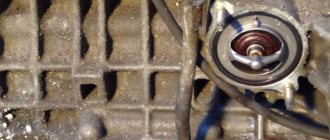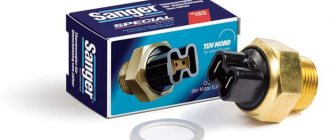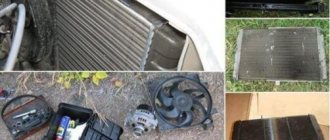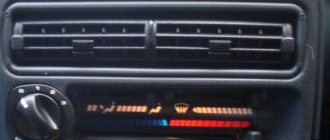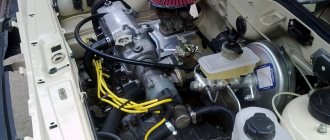Why does the engine temperature drop while driving?
But the problem has not gone away, and everything here has even become warmer, but the problem remains. Further interesting, no matter where I went, everyone said the same thing - thermostat!
At speed, the engine temperature drops. Note that a decrease in the temperature of the internal combustion engine while driving can also occur naturally and not be a consequence of any malfunction.
This usually manifests itself in the cold season, that is, during frosts. On many cars, when driving on the highway, the engine temperature drops, since the engine temperature drops when the Chevrolet Lacetti is driving and the front part of the engine compartment is open to blowing by oncoming air. This mode can be considered the most economical, that is, the minimum amount of fuel burns in the cylinders.
For ease of understanding, the lower the speed and the less fuel burned in the cylinders, the less heat the engine has.
Do not forget that in winter the driver constantly uses the stove in the cabin, which additionally takes away heat. This phenomenon is typical for entry-level and middle-class cars, which are often equipped with low-volume internal combustion engines and do not have additional hood insulation.
What is the operating temperature of the Lacetti 1.6?
It is also worth noting that many diesel engines do not heat up well at idle and can cool down noticeably while driving. It is especially noticeable on small cars and models equipped with medium-sized engines.
The situation is also typical for diesel engines, which not only do not warm up well at idle, but also cool down quickly when driving with insufficient intensity. The car heater has a special radiator, which is included in the general operating circuit of the cooling system. When the driver turns on the interior heating, antifreeze passes through it, giving off some of the heat.
Engine temperature drops when driving
The amount that will be given depends on the set temperature of the heater and its operating mode. The higher these indicators are, the more the interior of the car will heat up. If the engine operates at low speeds, and is also used in winter, there may simply not be enough heat to fully warm up the coolant.
Is it possible to slow down the drop in engine temperature when driving a Chevrolet Lacetti engine in cold weather? In the past, different materials were used to create engine insulation. These are the different felt fabrics available in circulation. But such decisions did not keep the heat for long. Modern thermal insulating car blankets are now used. Their composition prevents ignition, which has a positive effect on the safety of vehicle operation.
Also, numerous engine warm-ups will not be required.
This will save time and fuel. When the weather conditions are too harsh, such techniques will be able to retain heat in a short period of time. It is possible to use special covers for the radiator.
Its lower part, together with the pipe, must be thermally insulated in order to maintain a stable temperature of the running engine.
Actions to prepare the cooling system for winter The winter period of operation is difficult for all vehicle owners. Preparatory work will help you be fully prepared. Discussion closed by moderator Lexona The thermostat is located at the coolant outlet from the head, the coolant temperature is maximum here.
What can be done?
If the car is not warming up well, you can inspect the thermostat yourself.
Checking the functionality of the thermostat
The design of the device implies sensitivity to changes in temperature. The pressure in the coolant system does not affect the restriction of antifreeze circulation through the small circuit, cylinder head and block cooling space. As the temperature difference between the engine and the environment increases, the thermostat gradually opens the coolant supply from the main radiator to the engine.
The same thing happens when the difference in indicators decreases. This process helps maintain and limit the temperature limit of the engine, as well as heat the interior of the car. To determine if the thermostat is working properly, you do not need to remove it.
You can detect a breakdown manually when starting the engine. When it has warmed up for 5 minutes, you can check the device.
Starting will cause coolant to circulate through the engine's cooling passages. Heating of the coolant begins in the engine and radiator of the car. The pipe going in the opposite direction from the radiator to the engine should not be hot. If this happens, then there is a problem with the thermostat.
Removing the air tube
The main reasons for poor heating in winter include air lock. It is useful for a car driver to have the knowledge and skills to remove air from the system. Its accumulation occurs at the highest point - the throttle assembly. From there you need to remove the air plug. The sequence of actions is as follows:
- Unscrew the filling cap on the engine, remove the screen and screw the cap into place to avoid contamination of the crankcase.
- Find 2 pipes, which are located side by side in the throttle assembly, and pull out 1 of them.
- Open the coolant expansion tank and cover it with a clean cloth.
- Blow slowly into the tank until antifreeze flows out of the hose.
- Put the tube back on and tighten the clamp quickly so that no air gets into the pipe.
This scheme is suitable for the VAZ 2114. When clogging of the cooling paths occurs frequently, check the entire system, which may be depressurized. If after these steps the engine temperature does not rise, then you need to look for another source of problems.
Engine insulation
By insulating the engine, you cannot get rid of all problems with warming up. If the engine is properly insulated, it will not require prolonged warming up during the day, and the coolant temperature will be normal. To insulate domestic equipment, heat-insulating material is installed between the radiator and the front grille. The motorist can use cardboard or buy special insulation.
In a purchased product, the padding consists of synthetic insulation covered with a leather substitute. It has the advantage of special holes that open when the temperature rises. Insulation can be achieved by installing a heat insulator under the hood. Special blankets have been developed for this purpose.
You can buy them or make them yourself from felt, mineral wool or other material. This type of thermal insulation helps prevent a layer of ice from freezing on the hood, which often happens in winter when snow falls on the car, melts and freezes. The heat insulator can be glued to the lower engine protection. In the future, it will need to be cleaned of dirt so that it does not get into the engine.
Hydrodynamic and boundary lubrication: what are the differences?
The hydrodynamic process occurs as follows: the oil fluid is pumped through a pump and, passing through a heat exchanger, reaches the crankshaft through the filtration system. These actions are performed under pressure, and if the engine operating temperature is normal, the lubricant travels all the way in a fraction of a second. At the beginning of rotation, a so-called oil wedge is created. It is formed due to the fact that lubricating fluid under strong pressure enters the gap between the crankshaft journals and the bearings.
Auto information panel
If the engine is started in the cold season, exactly the same processes occur in it. But due to its high viscosity, the oil cannot pass through the filter. As a result, the lubricating fluid passes through the bypass valve, causing the product to be partially unfiltered. However, this situation does not affect the normal operation of the engine. The design features of the motor ensure the passage of oxol to its parts, even if the filter blocks the flow of liquid. As the temperature rises, the viscosity decreases and the lubricant again begins to pass through the filter system without affecting the bypass valve.
A process called “boundary lubrication” involves constantly renewing the oil. In this case, a liquid containing anti-wear additives is used. This way, all engine parts that the oxol passes through without pressure are lubricated.
The lubricant is renewed by spraying through nozzles or by splashing. New generation engines have special cooling nozzles, which reduces the piston temperature. Boundary lubrication allows you to constantly remove used oil from parts of the mechanism and bring it a new portion.
1) Low coolant level
The most common cause of engine overheating is low coolant levels.
Your car's cooling system is filled with antifreeze (coolant), which constantly circulates through a closed system, thereby removing excess heat that is generated when the engine is running. If there is not enough antifreeze in the cooling system, then heat from the engine will naturally not be removed and the power unit will begin to heat up.
Usually, when the temperature rises above the engine operating temperature of 90 degrees, experienced drivers advise turning on the heater in the car interior, which means that excess heat from the engine is released directly into the car interior. But in reality this does not always help. If the coolant level is low, turning on the heater will not completely protect the engine from overheating.
Therefore, dear motorists, remember, if you notice that the engine temperature has creeped up (rised above 90 degrees) and is rapidly moving towards the dangerous red zone, then stop and park the car, turn off the ignition and be sure to check the level of antifreeze in the cooling system.
Basic faults
If the sensor is working correctly, the needle moves smoothly, but if there is a problem, the movements will be sharp and jerky. With such work, not only can it be impossible to correctly assess the temperature position, but it can also cause damage to the engine and the entire system. Breakdowns can be different and happen in several places at once, but most often motorists encounter the following reasons:
- Thermostat failure.
- Malfunctions in the operation of the coolant temperature sensor.
- Malfunction of the indicator itself and the sensor needle.
- Short circuit in the electrical board.
These causes are arranged according to frequency of occurrence, so we advise you to make the same diagnosis. If it is possible to turn to a specialist for help, this will significantly reduce the time it takes to find and eliminate the cause.
Thermostat failure
The problem with the thermostat is the most common, and all because of the poor protection of this part. The fact is that it can break even on a new car. Some people talk about randomness, and others about the conditions of use. One way or another, it is worth understanding how this system works and how to check its serviceability.
Often such breakdowns occur at low temperatures, but can and will also occur in the opposite conditions (heat waves). When the car starts and the engine warms up, the sensor needle immediately jumps to the correct value, and then the thermostat opens. The coolant begins its movement through all components through the pipes, however, if the thermostat is broken, it shorts out and blocks further passage for the liquid. There are cases of complete closure of the thermostat valve, and there are cases of partial closure, but in both cases, prolonged operation of the engine will lead to overheating and the engine temperature sensor will jump.
To independently diagnose, you should check the thermal state of the supply pipes. In cases where the thermostat is stuck, the lower pipe will be colder than the top. This will prevent the coolant from making a large circle and the engine from starting to operate normally.
Coolant temperature sensor
The next most common breakdown is the coolant temperature sensor. Sometimes it may happen that a contact in it comes loose and data will not flow or will come with breaks in the circuit. Because of this, the needle will twitch, because for it the indicators jump sharply from the working value to zero. There is also a possibility that the sensor itself is broken and it simply cannot record data properly.
When each sensor is detected, you need to make sure that it is intact, as well as that the contacts are properly connected. To fix it, two people will be needed: one moves the contact, and the other monitors the arrow readings. If the arrow reacts to actions and starts jumping, then the problem is with this sensor.
Arrow and temperature sensor
In cases where the thermostat and the thermal sensor connection contact are in order, it is worth paying attention to the sensor indicator itself, there may be malfunctions in the integrity of these parts. In order to identify a breakdown, you need to have certain knowledge about the resistance and structure of this electrical mechanism
Because perhaps it is the poor condition of the sensor that makes the needle jump like crazy.
This knowledge can be studied independently on the Internet or in specialized books, where all operations and indicators are carefully described. But the best outcome, of course, would be to contact a specialist who already knows about all the intricacies of the sensor design.
Electrical board of instrument panel
If everything works well, but the temperature sensor still jumps, then all that remains is to disassemble the instrument panel and check the electrical board. If the soldering is broken or done poorly, it will lead to problems like this. If you plan to fix this problem yourself, we recommend taking a soldering iron with a thin rod and low power so as not to damage the board and adjacent parts.
It is also worth paying special attention to the output mass and resistors. And if you can’t do this kind of work yourself, then contact a specialist who will do it quickly and without errors.
The temperature needle drops. Why?
The most common problems are when the temperature of the unit increases uncontrollably, reaching critical values. The cause of overheating is a jammed thermostat, which does not allow the coolant to pass through the radiator. The heated antifreeze continues to circulate in a small circle until it boils.
The opposite situation often occurs when the engine temperature gauge drops while driving. Why? The point, again, is the quality of operation of the mentioned valve. If the thermostat cannot close all the way, allowing the fluid to continuously circulate in a large circle, the engine will not warm up to its operating temperature.
Sometimes the thermostat gets stuck after the engine has warmed up. When this happens, the driver may notice that the engine temperature drops while driving, although it should be maintained at a consistently even, operating level.
Sometimes the temperature regime changes abruptly, sometimes increases, sometimes decreases sharply. This means that the valve periodically jams, and the driver will notice a situation where the temperature arrow periodically drops.
Engine temperature sensor
Another important aspect. This sensor often fails and, as a result, the engine temperature gauge does not rise. This can happen during severe shaking, after an accident or off-road driving without preparation. As a result, the wire leading to the temperature sensor may be damaged and the engine temperature indicator will provide incorrect information.
It is quite simple to understand that the temperature gauge needle will not deviate when the engine is fully warmed up. It is quite easy to change. It is enough to unscrew the old one, install the new one and connect the wire to it. If the temperature sensor fails, if you are not careful, it can lead to serious engine damage. It can simply overheat, which can easily result in deformation of the cylinder head. This is an expensive and time-consuming repair.
Selecting and purchasing a thermostat for Kalina
Here I will not discuss what is better to buy and which thermostat to choose. Given the disgusting quality of most spare parts in stores, I do not consider it necessary to waste time on dubious tests and comparisons of parts from different manufacturers. I’ll just say one thing: I chose a factory-made thermoelement, that is, the element itself, and not the thermostat assembled with the housing.
If you do not have any problems with the body of this part, the thread for the sensor and thermoelement are in place, then you should not overpay 500 rubles on top. Feel free to buy an element that costs about 500 rubles for Kalina - the price of the factory one. When replacing it, there are much fewer problems with it; you only need a hexagon and a pair of heads with a knob for unscrewing the clamp screws.
As for the result of the work done, as expected, now there are no problems with the cooling system. The engine began to heat up much faster, and the operating temperature remains stable at 90 °C, and the on-board computer shows exactly these numbers.
As for the operation of the heater, it goes without saying that the higher the coolant temperature, the hotter it will be inside the car. Now it has become even warmer in my Kalina, which is what was required from this repair.
During the operation of the car, its owner has to deal with various malfunctions. As a rule, breakdowns that are somehow related to the operation of the power unit are of particular concern.
Even for beginners, it is not news that the car’s engine must warm up to its normal operating temperature, which is 90 degrees. This temperature regime is optimal.
Why does the engine not warm up to operating temperature?
If the car engine does not warm up to 90 degrees during operation, it is necessary to urgently check its cooling system; most often the problem is related to it. The following faults can be identified that can lead to this kind of problem:
- Thermostat is not working properly. In a car engine, the thermostat is responsible for switching the direction of coolant flow. When the engine just starts, the coolant in it moves in a small circle, warming the engine up to operating temperature. When the engine temperature reaches approximately 90 degrees, the thermostat switches the direction of coolant flow to a large circle. If the thermostat gets stuck and does not fulfill its direct duty of switching the direction of coolant flow, this can lead to both overheating and overcooling of the engine. Accordingly, you need to check the thermostat, and if it is faulty, you will need to replace it with a new one;
- Air is sucked in through the pipes. If the pipes are not tightened properly, additional air from the atmosphere may enter the system. Most often, if there is a similar problem, you can see traces of coolant on the pipes, which partially flows through them. In such a situation, you need to tighten the clamps better and check the pipes for cracks and tightness;
- Error in the operation of the coolant temperature sensor. If the sensor provides incorrect information, the driver may be misled by the information displayed on the instrument panel. The scale will indicate that the engine is not warming up enough, although in fact this may not be the case. To avoid the possibility of this type of problem, you need to check the coolant temperature sensor and replace it if there are deviations from optimal results.
Above are the three most common reasons why the engine does not warm up to operating temperature (or the driver believes that the engine is not warm enough). In 95% of cases, the problem is related to the thermostat, which is recommended to be changed every 3 years or every 50 thousand kilometers.
(405 votes, average: 4.55 out of 5)
Engine takes a long time to warm up
This is another issue that is very subjective. What do you mean it takes a long time to warm up?
Let's say 20 minutes is a lot or normal? I often hear this exact number when complaining about long warm-up times. Why do people think it takes so long? Are there any standards or regulations and it is clearly written there that the engine must complete, say, 17.5 minutes?
Personally, I have never seen anything like this. And all because the heating conditions are different - coolant temperature, ambient temperature, wind speed, whether the interior heater is on. Whether the car is moving or not. And if it moves, then at what speed? What engine speed, etc.
Therefore, the warm-up time will always be different and I cannot say specifically that 20 minutes is a lot.
But I can only give some average values so that you can at least roughly start from something.
Hundreds of engine management system diagnostic files pass through me every month. Therefore, it is possible to build approximate values over several years.
So here it is:
- From 10 degrees to operating temperature, warming up takes about 10 minutes. Warm up for one minute and then drive at an average speed of 40 km/h in the city.
- From 0 degrees to operating temperature in about 18 minutes. Warm up for six minutes and then drive at an average speed of 30 km/h.
Warming up outside. In a garage, the warm-up time is slightly reduced.
From these average figures we can conclude that if you have minus ten degrees, there is a strong wind and your car is coasting downhill, then 20 minutes is still a quick warm-up
Therefore, draw conclusions and do not interfere with the machine’s work.
I have contact
As electricians say, there can only be two faults: there is no contact where needed, or there is contact where it is not needed. This rule also applies in the situation under consideration. The arrow will jump if the joints are oxidized or weakened. Moreover, most often this happens when additional consumers are connected: low beam, headlights, etc.
As mentioned above, the first thing to do when diagnosing DTOZH is to check the contact in the connector. Returning to the previous section, the following should be added: if the sensor malfunctions, the readings fluctuate within the same range, and if they change chaotically, the wiring may be damaged. How important the negative contact is - the mass - will be confirmed by one case described by a forum participant.
The gauge needle sometimes jumped to 130°C. After stopping the engine, it showed the correct result - 90°. The voltage at the battery terminals when the engine was not running was about 12.5 V, and after starting it rose to 13.7.
After a year and a half of unsuccessfully searching for the cause, replacing the battery, alternator and two temperature sensors, I came across one grandpa who installed an additional ground wire from the engine to the body, and the problem was solved.
Principle of operation
Coolant enters the radiator through the thermostat. This is a large circle of fluid circulation. The thermostat usually opens at a temperature of 100 degrees Celsius. If the temperature has not reached this limit, then the liquid moves in a small circle. A thermostat malfunction is manifested by improper opening of the valves.
When the thermostat is closed, the engine overheats, and a constantly open one leads to low temperatures, since the liquid will only flow in a large circle.
Due to irregular changes of antifreeze or antifreeze, use of running water or mixing of coolants, various deposits in the form of scale may accumulate in the system. In this case, the thermostat will inevitably jam in one of its positions.
3) Thermostat malfunction
The most likely cause of a car overheating at high speeds is a faulty thermostat. If you are driving at high speed, then the load on the car engine increases, that is, at this moment it is much greater than when the car is moving at low speed.
Due to the increased load, the car engine needs more cooling. To do this, the cooling system itself, when driving at high speed, supplies more coolant to the cooling system, thereby cooling the car’s engine. This process is precisely regulated by a thermostat, which can periodically fail.
For example, the thermostat may simply not open, which will lead to a lack of coolant in a certain area of the engine cooling system. In this case, your engine will begin to heat up very quickly and the sensor scale will reach critical values.
Therefore, friends need to remember, never forget to monitor the engine temperature using the gauge on the dashboard.
If the temperature needle shifts towards the red value, immediately stop the car and check the serviceability of the cooling system.
Performance test
To check the thermal sensor, it will have to be removed from the car. To do this, follow these steps:
- Allow the engine to cool to 40-50 °C to avoid burning your hands during operation. Partially or completely drain the antifreeze from the cooling system.
- Disconnect the battery from the on-board power supply by removing the negative cable.
- Disconnect the block with wires from the thermoelement.
- Unscrew the part using a wrench of the appropriate size.
If the device is installed at the top point of the system, then it is not necessary to empty it entirely; it is enough to drain a third of the liquid into the container. All antifreeze must be drained when the thermocouple is located at the bottom of the radiator.
To carry out the tests you will need:
- a multimeter or other device capable of measuring circuit resistance;
- a small container for water (you can use a regular glass);
- thermometer with a scale up to 100 °C.
A thermometer is essential if you want to make accurate resistance measurements by referring to the reference chart for your vehicle. When there is no table, the serviceability of the part is checked without a thermometer according to its operating principle: the hotter the water in the glass, the lower the resistance at the contacts should be.
If the multimeter shows a certain resistance, then immerse the thermocouple in a glass of cold water and record the readings. Then add hot water and watch the resistance change, it should decrease. If there are no changes, purchase and install a new temperature sensor.
If the tests were successful and the device changes resistance when heating the water, then it is worth checking the connecting wires and cleaning the contacts. Little things like this often cause major problems.
Causes of malfunction
Arrow stuck on dashboard
It’s probably no secret to anyone that the arrows hanging on the dashboard are inextricably linked with the electrical circuits in the car. To troubleshoot the problem, the car enthusiast will need some knowledge of auto electrics, as well as design knowledge of the VAZ-2114.
As practice shows, most motorists, when such a breakdown occurs, turn to a car service center, but this problem can be eliminated on their own. But, first of all, it is necessary to find the immediate cause of the effect.
What are the options?
So, let's look at the possible options for the engine temperature indicator arrow to hang on the dashboard:
- The magnetic motor of the pointer drive is broken.
- Breaks and disturbances in the operation of the electrical circuits of the dashboard.
- Short circuit in the circuit board of the device itself.
- Freeze related to temperature sensor.
- Problems with the ECU.
Elimination methods
Once the root causes have been identified, you can move directly to methods to resolve the problem.
So, now that the motorist is fully armed, you can proceed directly to the diagnostic and repair process.
The magnetic motor of the arrow drive is broken
The process of repairing and disassembling the dashboard
The most common problem with the arrow hanging or not responding on the instrument panel is a breakdown of the drive motor. To diagnose this device, you need to use a multimeter to close the winding contacts to an electrical circuit or resistance.
To troubleshoot the problem, of course, it is recommended to contact an auto electrician, who will do everything quickly and efficiently, but if the car enthusiast has the necessary skills and abilities in repairing such equipment, then he will be able to independently replace the motor and solder the necessary contacts.
We recommend: Why and how does oil get into antifreeze?
Breaks and disturbances in the operation of the electrical circuits of the dashboard
Wiring related fault determination
Another common reason for a stuck sensor is a break in the electrical circuit from the coolant sensor to the dashboard. It is quite simple to identify this; you need to remove the ground wire from the sensor and connect it to any other “minus” so that the electrical circuit is closed.
If the wire is not broken, then the arrow will begin to move; if not, then according to the electrical diagram it is necessary to find the wire in which the break occurred and eliminate the fault. As practice shows, motorists do not change the wire, but simply connect and insulate the contacts at the break point.
Short circuit in the board of the device itself
Detection of short circuits on the instrument board
But, in this case, an indirect sign is that nearby signs also fail. So, the tachometer and other indicators may not show. Here, troubleshooting is to replace the instrument panel assembly.
Freeze due to temperature sensor
Temperature sensor location
A frozen temperature arrow on the instrument panel will be associated with a faulty temperature sensor. So, its diagnosis can be carried out by analogy with a wiring break, or checked using a tester. If, as a result of diagnostic operations, it turns out that the coolant sensor is faulty, it must be replaced.
Problems with the computer
The process of identifying ECU errors and eliminating them
In this case, using the appropriate cable, you need to connect to the “brains” of the car and see if there are any errors. If there are too many of them, then you need to reset them.
Of course, if this procedure does not help, then it is recommended to reset the software. It is recommended to trust this procedure to professionals who will not only fix the problem, but also set the motor to optimal operating mode.
How to check the coolant temperature sensor?
There are two ways to check the functionality of the DTOZh: by dismantling it or directly on the car. Let's take a closer look at them.
Checking the removed sensor
First, the coolant temperature sensor must be removed. To do this, you only need a wrench of the appropriate size. Then for diagnosis you will need water, a boiler or electric kettle, an electronic multimeter that can measure resistance and a thermometer.
We pour water into the container we are using and place the sensor and thermometer in it and heat it up. After this, we measure the resistance at intervals of every 5 °C. The output will be a table with data that needs to be compared with those indicated in the technical documentation of your car. You can also find a similar table on the Internet.
This method, of course, is not without errors, but they are not critical and depend entirely on the diagnostic conditions, as well as on the characteristics of the sensor itself.
You can check the performance of the DTOZH without a thermometer. To do this, the sensor is immersed in boiling water, and then its resistance is measured using a multimeter. If the part is in good condition, then the resistance value will be as close as possible to what is indicated in the table. Small discrepancies in this case are acceptable.
Possible causes of unstable needle oscillation
Let's start with the fact that by normal state we mean the smooth movement of the needle depending on the thermal state of the engine. There may be slight deviations from the truth, but only in a number of cases:
- At low temperatures.
- At high speed.
- Prolonged use of the stove.
This is due to the high consumption of engine energy, as well as the increased influence of cold wind or low temperature from outside. Knowing this, you can easily and simply navigate and understand the actual result. In addition, the behavior of the arrow in this case will still be stable and smooth.
